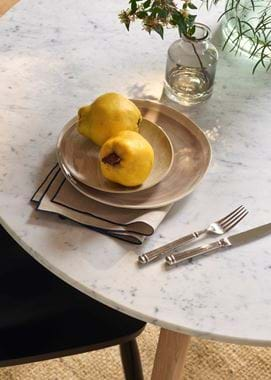On Quince by Kassia St Clair
On Quince by Kassia St Clair
After a century of quiet neglect, the quince (as a fruit) is still often overlooked today. Would you know one if you saw it, peeking out from the dense, juicily verdant foliage of its parent tree? Easy to mistake for apples or pears (although far less common), they’re usually the size of a large Bramley and slightly knobbed. Come late autumn, as they ripen, they develop a distinct, honeyed aroma. Downy bloom stipples their skins, which range from soft chartreuse to lemon yellow. Raw, their flesh is unyielding and so astringent that an unwary bite will leave you pucker-mouthed and spitting. It’s only when cooked – usually simmered with honey or sugar, some spices and a little lemon – that they reveal their savour. Creamy flesh softens and blushes pink, the flavours mellowing to resemble something akin to guava, caramel and marmalade.
Quince undoubtedly has an unimpeachable pedigree. Originally found growing wild in the foothills of the Caucasus mountains between the Black and Caspian seas, they were picked up by the traders plying the region and spread across the globe. Some believe Samarkand’s legendary golden peaches were, in fact, quinces. Others say the same for the biblical apple. Certainly, they were so beloved in Ancient Greece that they became something of a cultural trope. The ‘golden apple’ that the mortal Paris was said to have presented to the goddess Aphrodite, a choice that precipitated the Trojan War, was likely a quince. Thereafter, they were thought to be Aphrodite’s fruit, associated with love and fertility and adopted into wedding ceremonies from at least the 6th century BCE. Pliny the Elder wrote that ‘great men’ kept a bowlful in their rooms, presumably for their seductive floral scent. They were also much admired elsewhere in Europe. Charlemagne decreed that quince trees should be planted in all royal gardens. A quince jelly was presented to Joan of Arc in 1429 after she liberated Orleans from the English. And the 10th-century vizier to the ruler of Cordoba in Spain wrote an entire poem in their honour, admiring their sun-bright hue and comparing their smell to ‘the perfume of a loved woman’.
Greens of all shades have had a swell in popularity over the past five years, but there is something about quince’s crisp, yellow-toned character that makes it feel especially fresh. It’s something of a chameleon, able to evoke a myriad different moods – from antique to modern, serene to invigorating – depending on the context. The parent fruit might be an unregarded treasure, but its signature hue is surely due a well-deserved resurgence.
If you’d like to experiment with using Quince in your own home, you can order a sample pot online here. Kassia St Clair is a writer, cultural historian and the author of ‘The Secret Lives of Colour’.









